VOL.192 MAY 2024
JAPAN’S HEALING FORESTS (PART 1)
[Discovering Japan Through the Eyes of Japanese Influencers] Art Inspired by the Seasons: Wagashi
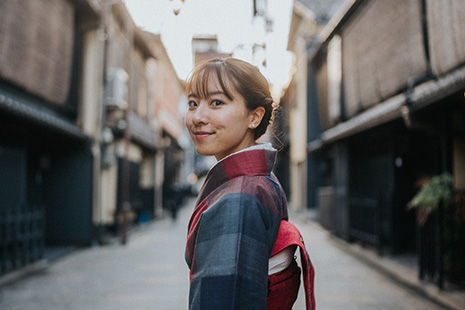
Wagashi is a general term for the kind of sweets that have been made in Japan since ancient times. They are characterized by the use of various plant-based ingredients such as beans and rice. Wagashi design changes with the seasons, with some popping up only at certain times of the year, like Halloween costumes, and others conveying the spirit of the season through their appearance, like Christmas coffrets.* Just as favorite seasons come and go in a regular pattern, the availability of specific types of Japanese sweets only at certain times of the year is both a tease and a delight. Let’s follow wagashi on a journey through the year in Japan.
Spring wagashi
In spring, there are many light-colored sweets that evoke the image of budding plants. Sakura mochi, a typical example of spring wagashi, comes in two styles: Kansai style and Kanto style.** Kansai-style sakura mochi are light pink mochi*** glutinous rice cakes filled with azuki bean paste (with some beans left whole) and wrapped in pickled sakura cherry leaves. In the Kanto region, the azuki bean paste is rolled in a crepe-like dough, which is then wrapped in a pickled sakura cherry leaf. Sakura mochi is so popular, it can even be found in convenience stores and supermarkets outside of the spring season.
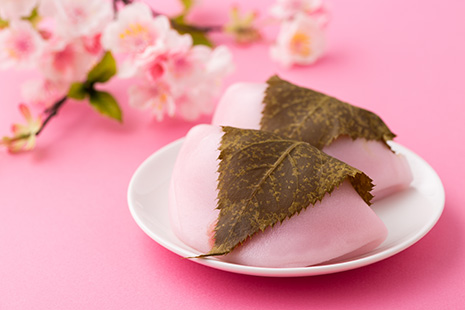
Summer wagashi
During the hot and humid Japanese summer, cool-looking smooth sweets made with agar or kuzu are especially popular. Minazuki is a wagashi made with a jelly-like base made to resemble a small piece of ice and topped with azuki beans. In Japan, the color red is traditionally believed to keep evil spirits away, so this wagashi, with the hope that the red beans on top will do just that, symbolizes wishes for good health and happiness.
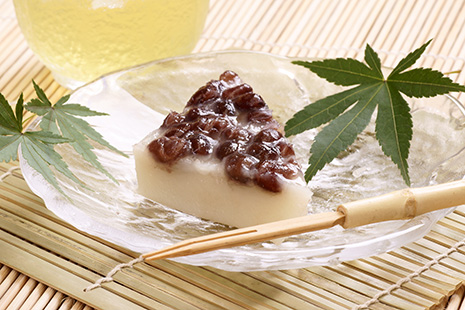
Autumn wagashi
As the season of chestnuts and sweet potatoes, autumn is known for wagashi such as kuri-kinton (candied chestnuts and sweet potatoes) and imo-yokan (sweet potato jelly). Besides, there is also a genre of Japanese confectionery called “nerikiri,”**** is made with white bean paste and sugar as the basic ingredients. Nerikiri sweets are made all year round, while they express a seasonal feeling with their distinctive designs and motifs. In autumn, nerikiri are shaped to resemble motifs such as colorful leaves and pumpkins.
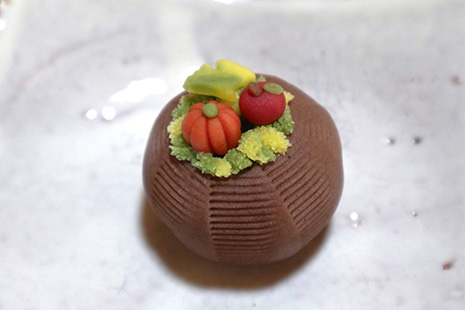
Photo: Kaaisan
Winter wagashi
Zenzai is a popular Japanese winter wagashi among ordinary households in the Kansai region. It is made by simmering azuki beans with sugar and adding mochi cakes to the mixture to create a warming and delightful winter treat. Hanabira mochi, served mainly in Kyoto on New Year’s Day, is a thin layer of mochi wrapped around a filling of white miso-an bean paste, and a slice of burdock root. The origin of this treat can be traced back to around the 10th century, when there was a custom of praying for longevity by eating something hard (hagatame*****).
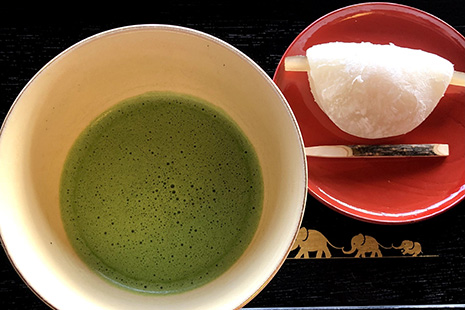
Photo: Kaaisan
Some popular wagashi are available year-round at supermarkets and convenience stores, but if you want to experience the real world of traditional Japanese confectionery, specialty stores are the place to go. There is even a Japanese proverb, “For mochi (rice cakes), go to the mochi shop” (“Mochi wa mochiya”), which uses the popular wagashi ingredient (mochi) to express the idea that it is best to leave things to professionals in each field. Learning about the background and motifs of Japanese sweets will help you appreciate their flavors better and enjoy them even more.
Kaaisan
Creator of English-language short film introductions to Japan. She manages an online community for like-minded people interested in Japanese culture and worldview to meet and learn together. She also plans and organizes various events on an irregular basis.![]()
* Limited-edition cosmetic kits released by various brands in time for the Christmas season
** Kanto: a large area roughly consisting of Tokyo and the surrounding prefectures. Kansai: an area roughly consisting of Kyoto, Osaka, Kobe and the surrounding prefectures.
*** Kansai-style sakura mochi is made from domyoji flour, which is prepared by steaming glutinous rice called mochi gome, drying it, and then grinding it with a coarse millstone. Kanto-style sakura mochi uses a crepe-like dough made from wheat flour and refined rice flour.
**** In addition to describing a type of Japanese confectionery, nerikiri can also refer to the dough used to make wagashi itself, which is a white bean paste kneaded with an added thickener.
***** On the 100th day after a child’s birth, the family holds a traditional Japanese ceremony called okuizome (literally “first meal”). After pretending to feed the baby a variety of foods, the parents perform a ritual called hagatame no gishiki (literally, “tooth-hardening ritual”). They touch the tip of the chopsticks to a pebble prepared along with the food, and then gently place the tip on the baby’s gums as an expression of their hope for the baby to have strong teeth and live a long life. (See Highlighting Japan, May 2023.)
By Kaaisan
Photo: Kaaisan; PIXTA

